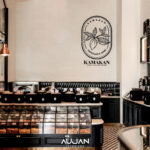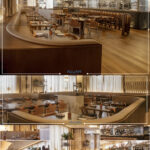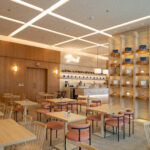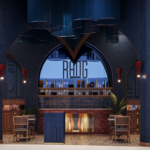Introduction
In the realm of interior design, achieving the perfect fitout requires more than just a keen eye for aesthetics. It demands a deep understanding of spatial dynamics, functionality, and user experience. Whether you’re revamping your office space or redesigning your home, mastering the five basic principles of interior fitout is paramount. From maximizing space utilization to ensuring optimal functionality, this comprehensive guide will equip you with the knowledge needed to transform any interior into a harmonious blend of form and function.
Understanding Interior Fitout
Before delving into the specifics, it’s essential to grasp the concept of interior fitout. Essentially, fitout refers to the process of designing and furnishing interior spaces to optimize functionality, aesthetics, and usability. It encompasses everything from spatial planning and layout design to selecting furniture, fixtures, and finishes. A well-executed fitout not only enhances the visual appeal of a space but also improves its functionality and efficiency.
The Key Principles
Space Optimization
Efficient space utilization lies at the core of any successful interior fitout. Whether working with a compact apartment or a sprawling office complex, maximizing space is essential. Embrace multifunctional furniture, utilize vertical space, and incorporate clever storage solutions to make the most of every square inch.
Utilizing Multifunctional Furniture
One of the most effective strategies for optimizing space is investing in multifunctional furniture pieces. From sofa beds that double as guest accommodations to extendable dining tables, these versatile pieces help maximize functionality without compromising on style.
Functionality
Beyond aesthetics, a well-designed interior must prioritize functionality. Every element should serve a purpose and contribute to the overall usability of the space. Consider the needs and activities of the occupants when planning the layout and selecting furnishings.
Prioritizing Ergonomics
Ergonomics play a crucial role in ensuring the comfort and well-being of individuals within a space. Choose ergonomic furniture designs that support proper posture and reduce the risk of strain or injury. Pay attention to desk heights, chair ergonomics, and other ergonomic factors to create a comfortable and productive environment.
Aesthetics
While functionality is paramount, aesthetics also play a significant role in interior fitout. The aesthetic appeal of a space sets the mood, reflects the brand identity, and enhances the overall user experience. Strike a balance between form and function to create visually appealing interiors that resonate with occupants.
Harmonizing Colors and Textures
The careful selection of colors and textures can dramatically impact the look and feel of a space. Experiment with different color palettes and textures to create visual interest and evoke the desired atmosphere. Consider factors such as natural light, room size, and intended use when choosing colors and materials.
Flexibility
In today’s dynamic world, flexibility is key to adapting to changing needs and preferences. Design interiors that can easily evolve with the evolving requirements of occupants. Incorporate modular furniture, movable partitions, and adaptable layouts to accommodate future changes without major renovations.
Modular Design Solutions
Modular design offers unparalleled flexibility, allowing spaces to be reconfigured quickly and easily as needed. Invest in modular furniture systems, partition walls, and storage units that can be rearranged or expanded to suit changing requirements.
Sustainability
In an era of increased environmental awareness, sustainability has become a central consideration in interior design. Opt for eco-friendly materials, energy-efficient fixtures, and sustainable design practices to minimize environmental impact and promote a healthier planet.
Choosing Sustainable Materials
From reclaimed wood and recycled plastics to low-VOC paints and renewable textiles, there are numerous sustainable materials available for interior fitout projects. Prioritize materials that are responsibly sourced, durable, and environmentally friendly.
Frequently Asked Questions (FAQs)
Q: What are the key elements of interior fitout?
A: The key elements of interior fitout include space optimization, functionality, aesthetics, flexibility, and sustainability. Each element plays a crucial role in creating harmonious and functional interiors.
Q: How can I optimize space in a small room?
A: To optimize space in a small room, consider using multifunctional furniture, utilizing vertical space, and incorporating clever storage solutions such as built-in cabinets and shelving units.
Q: Why is functionality important in interior design?
A: Functionality is essential in interior design as it ensures that the space meets the needs and activities of its occupants. A well-designed interior should not only look good but also be practical and user-friendly.
Q: What role do aesthetics play in interior fitout?
A: Aesthetics play a significant role in interior fitout as they contribute to the overall visual appeal and ambiance of a space. By harmonizing colors, textures, and design elements, aesthetics help create an inviting and cohesive environment.
Q: How can I make my interior design more sustainable?
A: To make your interior design more sustainable, opt for eco-friendly materials, energy-efficient fixtures, and sustainable design practices. Choose materials that are responsibly sourced and have minimal environmental impact.
Q: Why is flexibility important in interior fitout?
A: Flexibility is important in interior fitout as it allows spaces to adapt to changing needs and preferences over time. By incorporating modular furniture and adaptable layouts, interiors can easily evolve to accommodate new requirements.
Conclusion
Mastering the 5 Fundamental principles of interior fitout is essential for creating functional, aesthetically pleasing, and sustainable spaces. By prioritizing space optimization, functionality, aesthetics, flexibility, and sustainability, you can transform any interior into a harmonious and inviting environment that meets the needs of its occupants.






